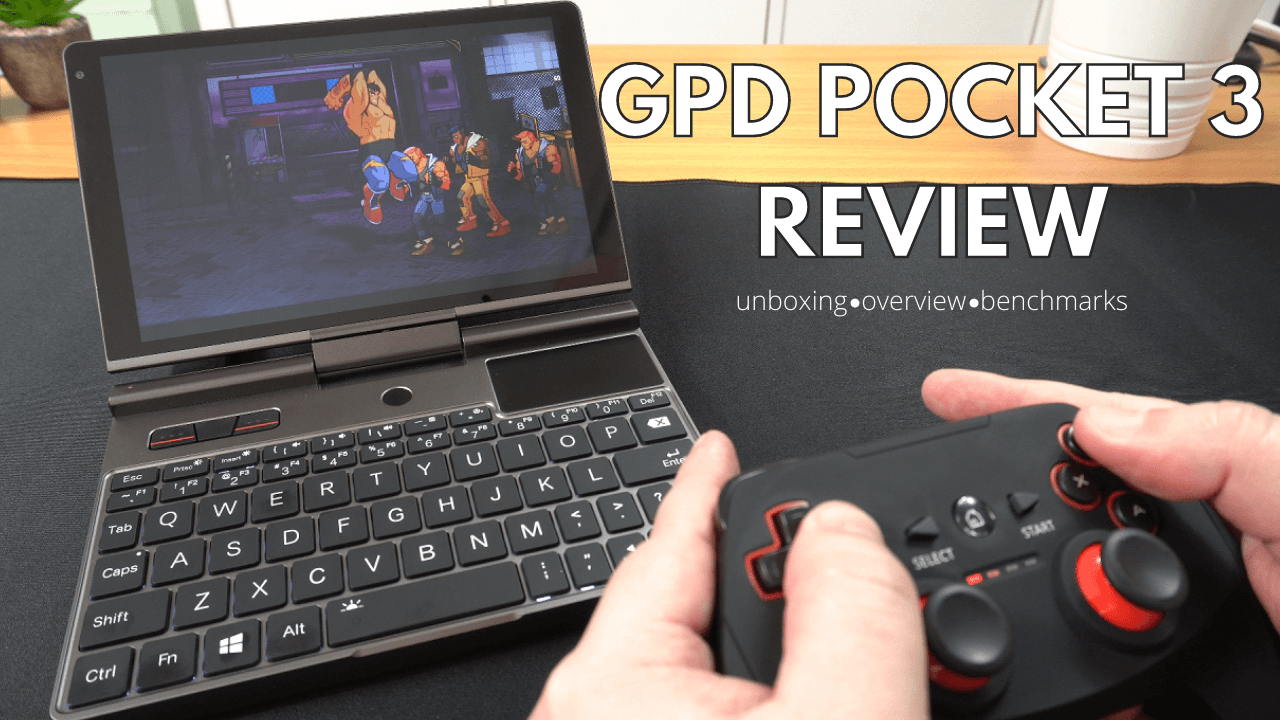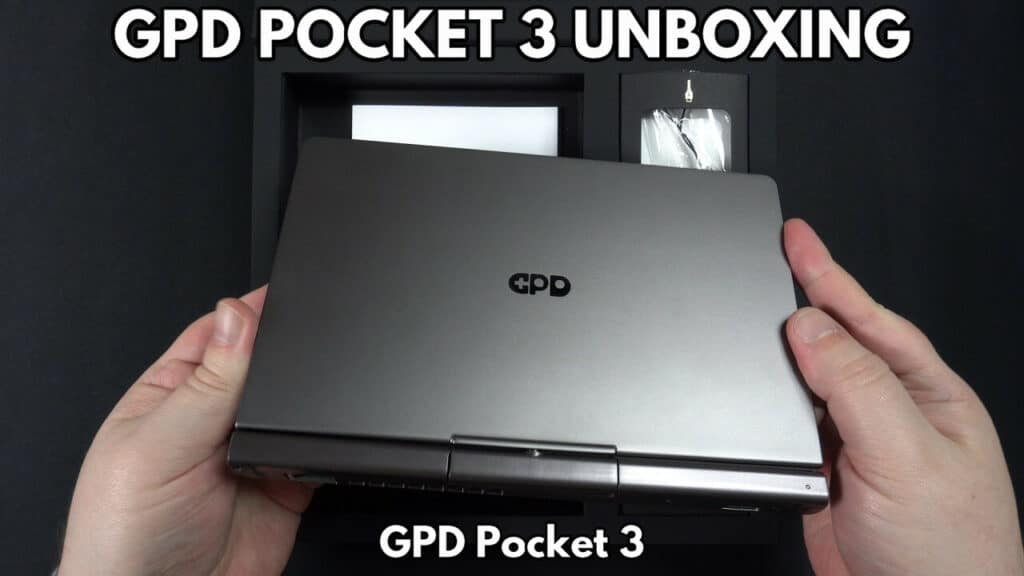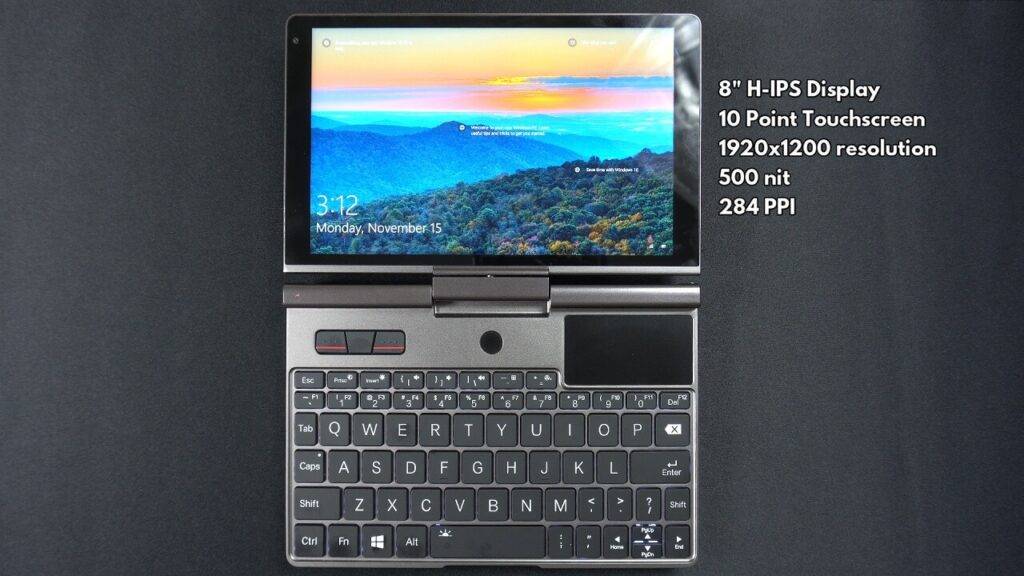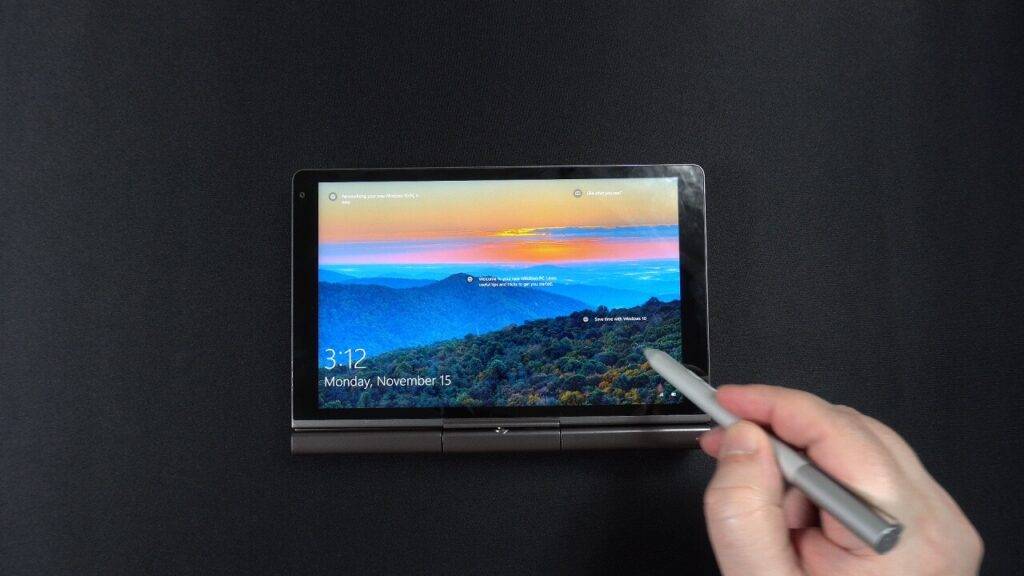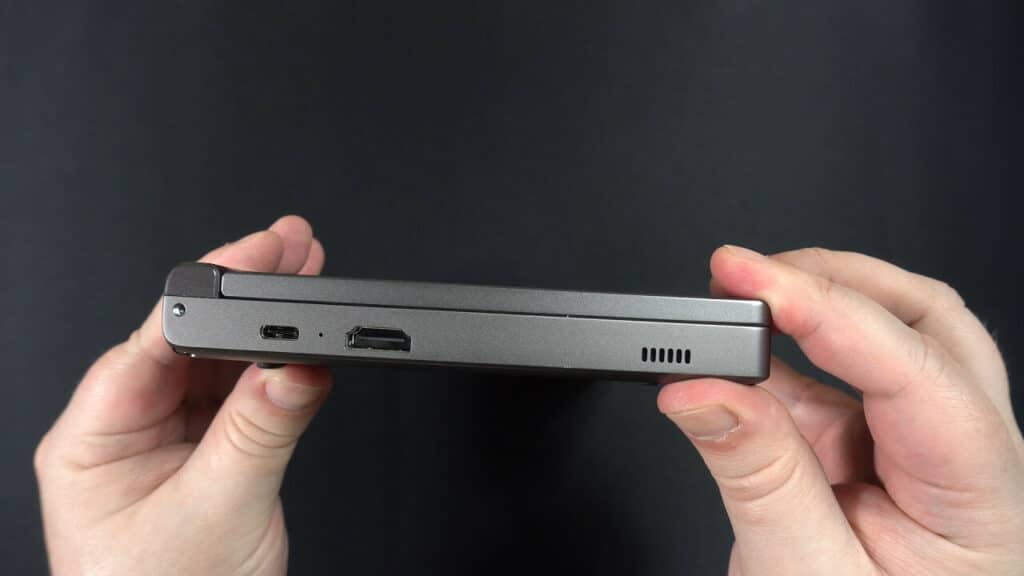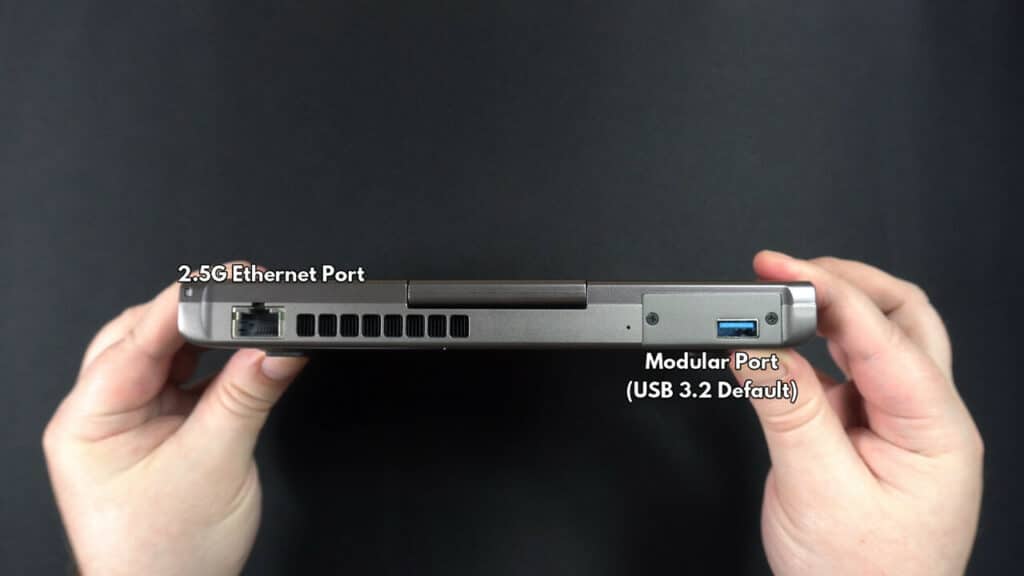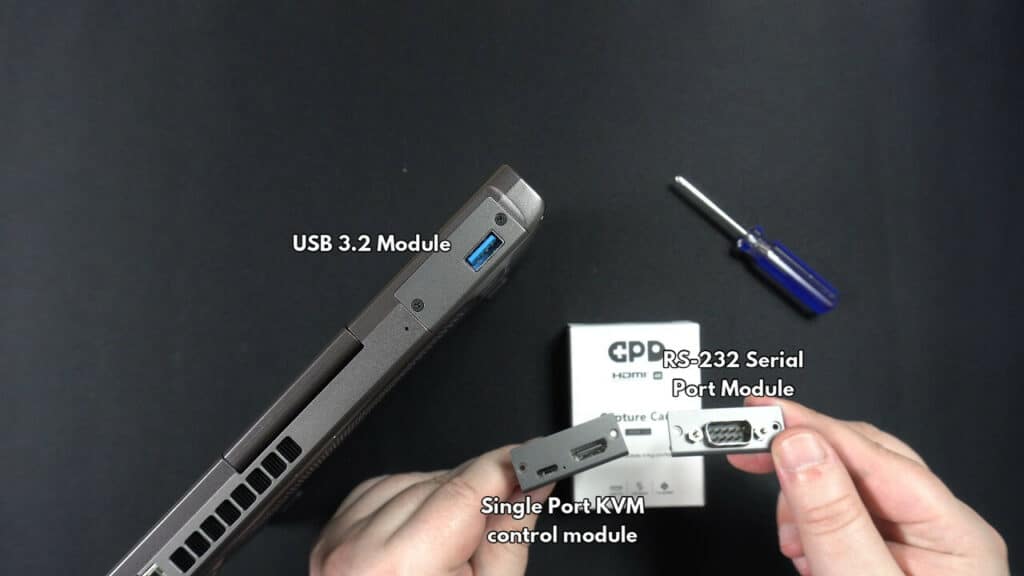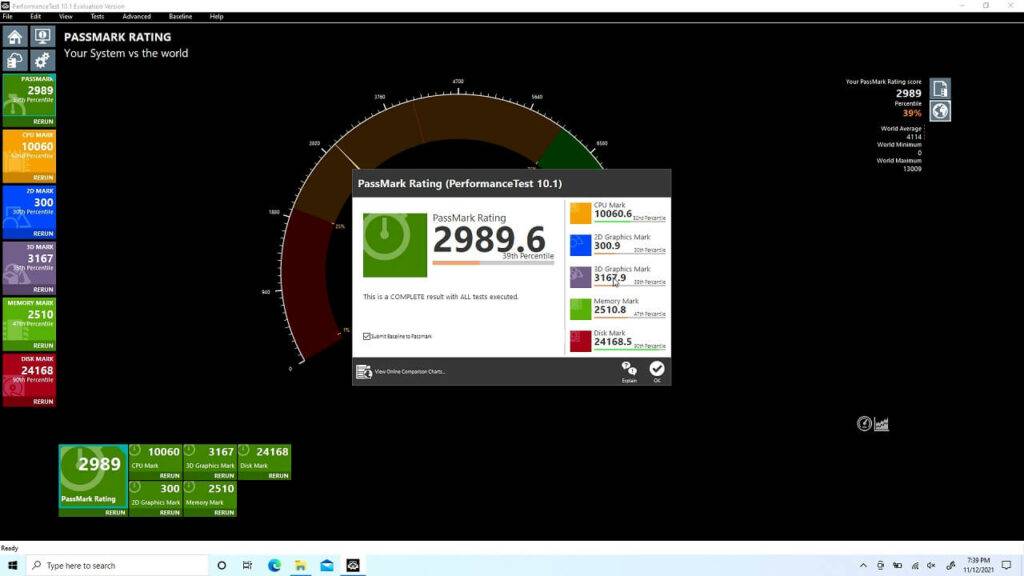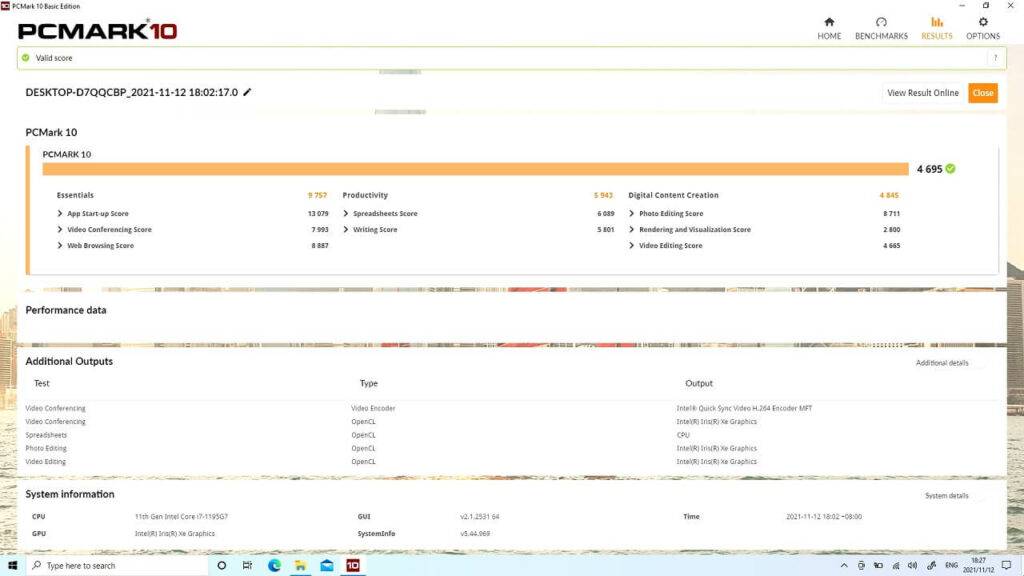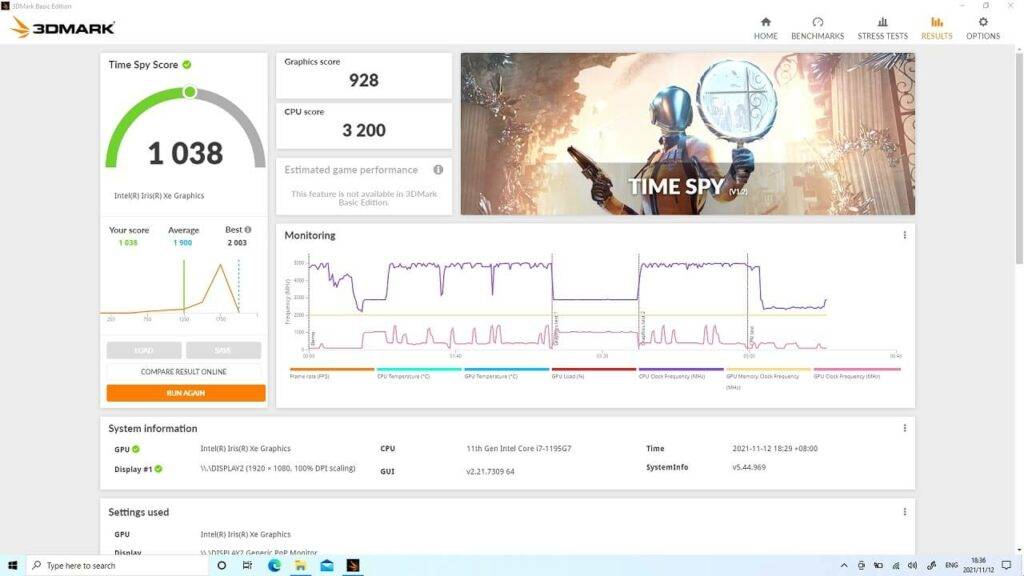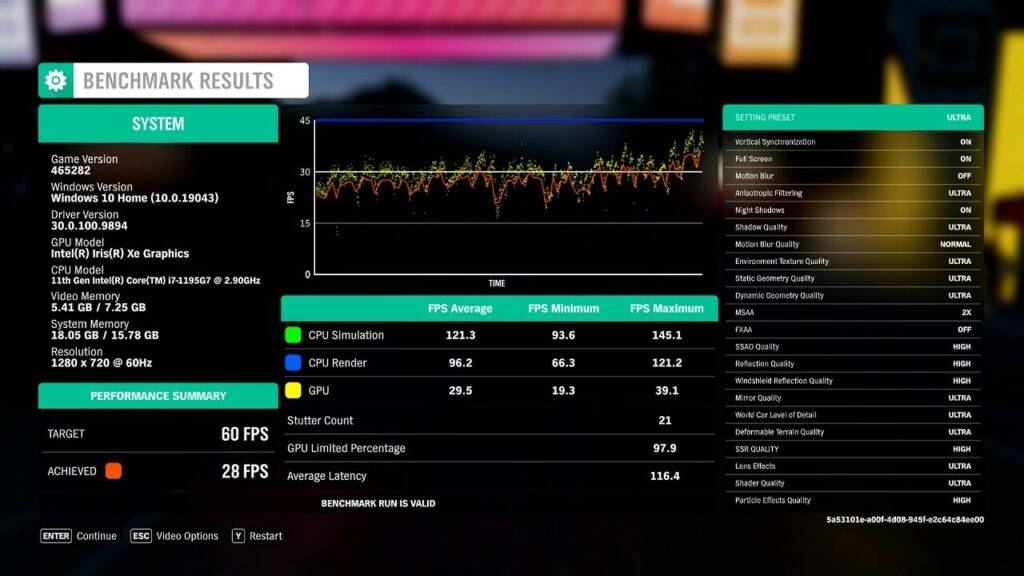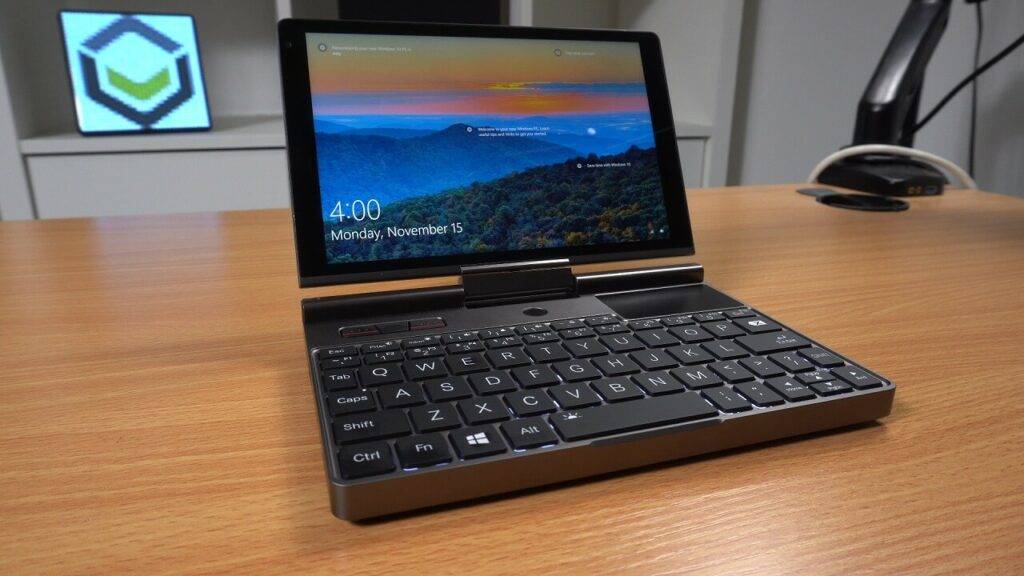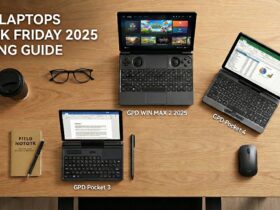GPD Pocket 3 läbivaatamine
-
Performance
(4.8)
-
Build quality
(5)
-
Features
(4.5)
-
Portability
(5)
Kokkuvõte
Suure jõudlusega mini sülearvuti, mis muutub tahvelarvutiks! Suurepärane aku kestab tavalise kasutamise korral ja modulaarportid tööstustöödeks RS-232 sidevahenditega.
Üldine
4.8Kasutaja ülevaade
( votes)Plussid
- Kiire Intel i7 1195G7 protsessor
- Äärmiselt kaasaskantav ja kerge
- Kuni 8 tundi aku kestvust
- Modulaarsed pordid laiendatavuse tagamiseks
- Pöörlev ekraan, mis muutub tahvelarvutiks
- Suurepärane ka mõneks mängimiseks
Miinused
- Üsna kallis
Täna vaatame oma ülevaates GPD Pocket 3 mini sülearvutit. Me võtame selle lahti, vaatame lähemalt selle funktsioone, sealhulgas selle modulaarset disaini, ning seejärel viime läbi mõned süsteemi- ja mängude võrdlusuuringud, et näha, kuidas see toimib.
GPD Pocket 3 ülevaatevideo
GPD Pocket 3 lahtipakkimine
Meil on GPD Pocket 3, mida me peagi lähemalt tutvustame.
Selle all on hiina- ja ingliskeelne kasutusjuhend. Pakendi all on Pocket 3 käterihm. Laadimiseks on USB Type-C kaabel. Ja viimasena, kuid mitte vähemtähtsana on laadija. Me lisame teie riigi jaoks õige adapteri, kui tellite meilt DroiXist.
GPD Pocket 3 ülevaade
GPD Pocket 3 on suletud kujul 7,8 x 5 x 0,78 tolli (19,8 x 12,7 x 2 cm) suur ja kaalub 725 grammi.
Pocket 3 tõuseb lahti, et avada 8-tolline H-IPS 1920×1200 resolutsiooniga ekraan, mis toetab 10-punktilist puutetundlikku juhtimist. Vasakul üleval on 2 megapiksline 1600×1200 piksline kaamera, mis sobib suurepäraselt videokõnedeks.
Pocket 3 aluse peal on vasak, keskmine ja parem hiirenupp. Keskel on sõrmejäljelugeja, mis toimib ka toitenupuna. Ja paremal on hiirenupp. Selle all on QWERTY-klaviatuur, mis on taustavalgustusega ja mida saab klahvikombinatsiooniga ümber lülitada.
Ekraani saab pöörata päripäeva ja kokku voltida, et muuta sülearvuti tahvelarvuti stiilis seadmeks. Seda saab kasutada koos pliiatsiga, mida saab osta eraldi.
Üks märkimist vääriv asi on see, et puudub sensor, mis kontrolliks, kui ekraani pööratakse. Ekraan ei orienteeru automaatselt ja seda peaksite tegema käsitsi. Uuendus: mudelil on nüüd gürosensor, mis suunab ekraani automaatselt õigesse asendisse.
Paremal küljel on 3,5 mm kõrvaklapipesa ja kaks USB 3.2 porti.
Vasakul küljel on USB Type-C port ja HDMI-väljund teleri või monitoriga ühendamiseks. Type-C port on Thunderbolt 4 ühilduv ja seda saab kasutada koos erinevate lisaseadmetega, näiteks keskuse või isegi välise graafikakaardiga.
Tagaküljel on 2,5 gigabitine Ethernet-port. Sellele järgneb modulaarne port, mida me näitame lähemalt järgmisel korral.
GPD Pocket 3 modulaarne port
GPD Pocket 3-l on modulaarne port, mis võimaldab vahetada moodulit, et pakkuda muid sisend-/väljundivõimalusi. Pocket 3 puhul on vaikimisi paigaldatud USB 3.2 moodul.
Eraldi on saadaval ka muid võimalusi, näiteks RS-232 jadaport tööstusliku andmeside jaoks. Ja üheportiline KVM-juhtimismoodul, millel on HDMI- ja USB-tugi.
Moodulite vahetamine on väga lihtne. Lihtsalt keerake kaks kruvi lahti. Eemaldage moodul ja sisestage asendusmoodul. Seejärel keerake see tagasi ja olete valmis!
GPD Pocket 3 tehnilised näitajad
| GPD POCKET 3 ALUS | GPD POCKET 3 HIGH END | |
| CPU | Intel Pentium Silver N6000 4 tuuma 4 niiti | Intel Core i7-1195G7 4 tuuma 8 lõime |
| BAAS / MAKSIMAALNE SAGEDUS | 1.10Ghz / 2.50Ghz | 2.90Ghz /4.60Ghz |
| GPU | Inteli UHD graafika @ 850Mhz | Intel Iris Xe graafika @ 1.40Ghz |
| RAM | 8GB LPDDR4x @ 2933Mhz | 16GB LPDDR4x @ 3733Mhz |
| LAOSTAMINE | 512 GB NVMe 1.3 PCIe Gen 3.0 x4 | 1TB NVMe 1.3 / 1.4 PCIe Gen 3.0 / 4.0 x4 |
| KONNEKTSIOON | 2,5 Gbit/s RJ45 kaudu IEEE 802.11 a/b/g/n/ac/ax - Dual Band Wi-Fi 6 Bluetooth 5.0 | 2,5 Gbit/s RJ45 kaudu IEEE 802.11 a/b/g/n/ac/ax - Dual Band Wi-Fi 6 Bluetooth 5.0 |
| BATTERI | 38.5Wh 7.7V = 5000mAhx 2 seeria Li-polümeeri aku | 8.5Wh 7.7V==5000mAhx 2 seeria Li-Polymer aku |
Süsteemi võrdlusnäitajad
Kuigi Pocket 3 kasutab sama i7 1195G7 protsessorit kui GPD Win 3 ja GPD Win MAX 2021 mängukonsoolid. See on vaikimisi madalama TDP-ga 15W, mitte 20W nagu teised. TDP on seadmele pakutav võimsus. Mida rohkem energiat antakse, seda suurema jõudlusega seade töötab, kuid selle eest kulub rohkem akut. Madalama TDP-ga töötamine vähendab jõudlust ja kasutab vähem energiat.
Kui TDP on seatud 15W, aitab see aku energiat säästa. Väga suur jõudlus ei pruugi olla vajalik selliste ülesannete jaoks nagu veebi sirvimine või töö kontoridokumentidega. Loomulikult võite suurendada TDP-d 20W-ni, et saavutada mängukonsoolidele vastav suurem jõudlus, kuid selle arvelt tuleb kasutada rohkem akut.
PassMark
Alustame meie võrdlusuuringut PassMarkiga, mis paneb protsessori, GPU, RAM-i ja salvestusruumi maksimaalsele võimsusele kunstlike testide käigus, et saavutada maksimaalne jõudlus.
Pocket’i skoor on 2,989, mis on väga hea tulemus mini sülearvuti jaoks.
PCMark
Meie järgmine test on PCMark, mis on rohkem teie igapäevase kasutuse seeria jõudlustestid alates veebi sirvimisest, videokonverentsidest, meediatarbimisest ja suurte kontoridokumentide tarbimisest.
GPD Pocket 3 hindeks on 4,695. Siinsed hinded on väga head, sest see tähendab, et käivitusaeg on kiire ja tarkvara laadimine on keskmisest kiirem. See kehtib ka suurte kontoridokumentidega töötamise kohta, mida on kiirem avada, töödelda ja seejärel salvestada.
3DMark
Meie viimane süsteemi võrdlusuuring on 3DMark, mis testib CPU ja GPU üheskoos nende jõudlust sellistes ülesannetes nagu video dekodeerimine, pilditöötlus ja muidugi mängimine.
Pocket 3 saavutab korraliku 1,038 punkti. Kui töötate piltide või videotega, siis näete selle mini sülearvuti suurepärast jõudlust!
GPD Pocket 3 läbivaatamine: Mängude võrdlusnäitajad: Mängude võrdlusnäitajad
Käivitame need testid 15W TDP-ga, nii et tulemused on madalamad kui GPD mängukonsoolidel, kuid nagu mainitud, saab seda suurendada 20W-ni, et saavutada sarnane jõudlus.
Forza Horizon 4
Alustame mängude testimist Forza Horizon 4′ga, mis töötab 1280×720 Ultra seadete juures. GPD Pocket 3 saavutab 28 kaadrit sekundis.
Street Filter V
Järgmisena testime Street Fighter V’i, mis töötab 1920×1080 ja maksimaalsete seadetega. Pocket 3 saavutab korraliku 33,4 kaadrit sekundis.
Final Fantasy XIV
Järgmisena käivitame Final Fantasy võrdlusuuringu 1920×1080 juures High Desktop’i seadetes. Modulaarne sülearvuti saavutab 2,992 punkti. Mõningate väikeste graafikasätetega saad sa edetabeli tavalisele tasemele.

Shadow Of the Tomb Raider
Meie viimane test on hauaröövli varju jaoks. Me kasutame 1280×720 resolutsiooni, käivitades testi madalaimate ja kõrgeimate graafika seadetega, et võrrelda.
Pocket 3 saavutab 32 kaadrit sekundis kõige madalamatel graafika seadistustel ja 20 kaadrit sekundis kõige kõrgematel seadistustel. Need on korralikud tulemused.
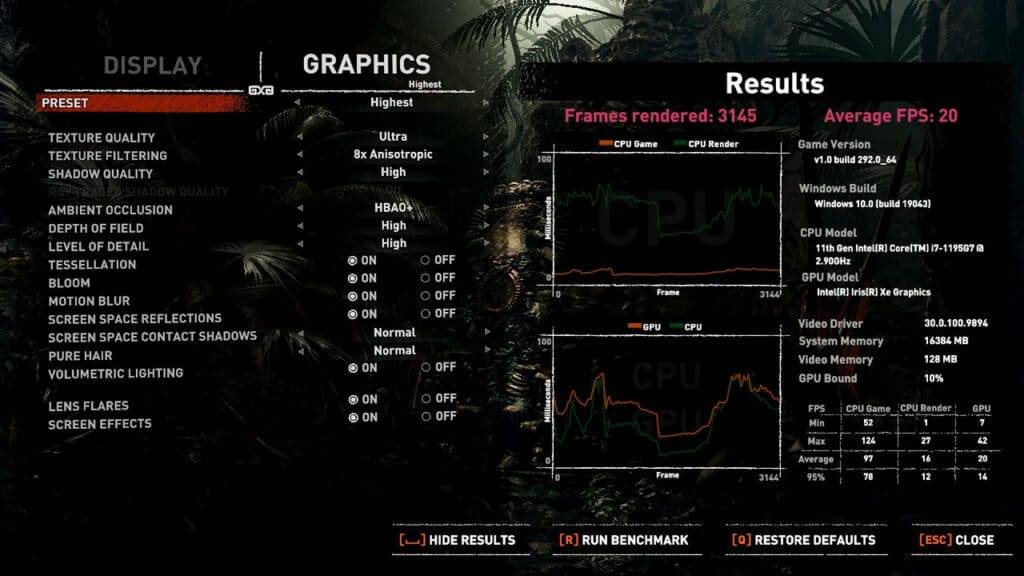
GPD Pocket 3 läbivaatamine: Benchmark kokkuvõte
Kiire kokkuvõte võrdlustulemustest ja aku testimisest täiskoormuse all, mille oleme teinud GPD Pocket 3 Review jaoks.
| GPD POCKET 3 HIGH END | |
| PASSMARK | 2,989 |
| PCMARK | 4,695 |
| 3DMARK | 1,038 |
| FORZA HORIZON 4 | 28 FPS |
| TÄNAVAVÕITLEJA V | 33,4 FPS |
| FINAL FANTASY XIV | 2,992 |
| VARJUS HAUARÖÖVEL | Madalaimad vaikimisi seaded: 32 FPS Kõrgeimad vaikimisi seaded: 20 FPS |
| AKU TESTIMINE | Tühikäigul: 8 tundi Täielik koormus: 1 tund 58 minutit. |
Arvestades, et need testid viidi läbi vaikimisi 15 W TDP-ga, on tulemused väga head nii süsteemi kui ka mängude võrdlustestide puhul. Kasutades toodet oma igapäevaste ülesannete jaoks ettenähtud viisil, täidab see neid väga hästi ja säästab ka aku kasutusaega.
Mõne mängimise kõrvalt võid otse tegutsema hakata või kui soovid lisajõudlust, võid suurendada TDP-d 20W-ni, et saada rohkem GPD mängukonsoolide jõudluse piirkonda.
Meie aku kestvustesti tulemused on umbes sellised, mida GPD esitas. Täieliku koormuse korral kestis aku 1 tund 58 minutit. Töölaua tühikäigul olles nägi umbes 7-8 tundi aku kestvust.
GPD Pocket 3 läbivaatamine: GPD Pocket GPD: kokkuvõte
Lõpetuseks meie GPD Pocket 3 ülevaatus, me arvame, et GPD Pocket 3 on väga muljetavaldav! Meile meeldib, et ekraani saab pöörata, et see muutuks tahvelarvuti stiilis seadmeks. Kuigi ekraani automaatne orienteerumine ei ole natuke pettumust tekitav. Protsessor on väga suure jõudlusega ja kui vajate mängimiseks lisajõudu, siis saate TDP-d hõlpsasti suurendada.
Meile meeldib modulaarne konstruktsioon, mille puhul saate mooduleid vajaduse korral välja vahetada. Näiteks RS232 port on suurepärane IT-tehnikutele, nagu ka KVM-moodul. Loodame, et tulevikus ilmuvad veel mõned moodulid!
Keskmise igapäevaste ülesannete täitmiseks kodus ja tööl, kuni kõrgema taseme rakendusteni, unustamata ka natuke mängimist, ei leia te paremat mini sülearvutit kui GPD Pocket 3!
Kust osta GPD Pocket 3
Lisateavet ja GPD Pocket 3 saate osta siit. Tutvu GPD toodete või mini sülearvutite valikuga siin.
GPD Pocket 3 KKK - kõik, mida me seni teame
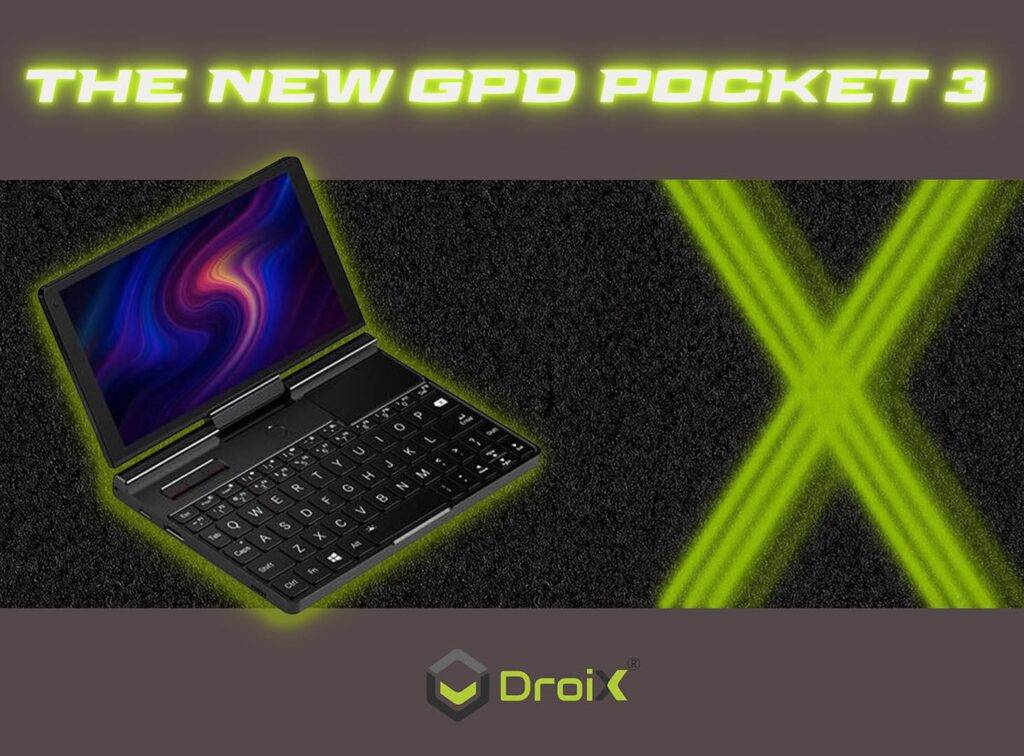
Algselt postitas benjamin kohta: 24/09/2021
Tere tulemast DroiX GPD Pocket 3 KKK - kus me kogume kogu informatsiooni, mida oleme võimelised GPD uusima tulevase sülearvuti, GPD Pocket 3 kohta.
Aasta lõpu lähenedes teatavad paljud firmad uuest riistvarast, mis tuleb turule, ja GPD ei ole erand, teatades lühikese aja jooksul kahest uuest tippklassi seadmest (esimene neist on GPD XP).
[30/12/2021 Update] Meie enda ülevaade, ettetellimise kuupäevad ja muud!
[30/12/2021 Update] Põrguvõrkude eemaldamine
Sellest on juba mõnda aega möödas, kui me seda KKK-d uuendasime! Nii et ärme raiska aega tühjade lõigete peale ja asume kohe asja sisusse.
Esiteks, kui te pole seda veel näinud. GPD Pocket 3 ametlik DroiXi ülevaade on nüüd veebis ja avalikkusele kättesaadav. Võite vaadata meie GPD Pocket 3 ülevaadet blogipostituses või vaadata allpool olevat videot, et rohkem teada saada selle suurepärase mini sülearvuti kohta.
Teiseks, GPD Pocket 3 on saadaval otse droix.co.uk ja droix.net. See hõlmab nii tipp- kui ka odavversioone.
GPD Pocket 3 praegune eeldatav saabumine DroIXi on nüüd jaanuari alguses. Kui nad saabuvad, täidetakse esmalt eeltellimused ja kui seadmeid peaks veel alles jääma, siis on need saadaval tavaliseks ostmiseks.
Me uuendame seda postitust, kui GPD Pocket 3 on saadaval. Nii et jääge seni kursis!
[12/10/2021 Update] IndieGogo, üksikasjad ja muud üksikasjad
Meie viimasest värskendusest on juba mõnda aega möödas! Vaatame kohe, mida uut on GPD Pocket 3 puhul.
GPD Pocket 3 IndieGogo/Crowdfunding üksikasjad
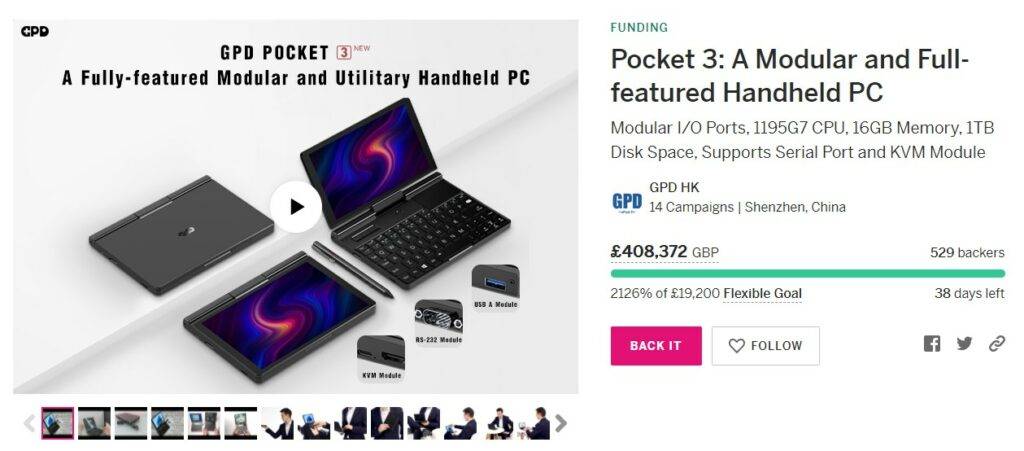
Kõigepealt on käivitatud GPD Pocket 3 ühisrahastuskampaania. Mõlemad versioonid, Pentium ja i7, saab osta koos pliiatsiga või väikese lisatasu eest koos nii pliiatsiga kui ka KVM/RS-232 moodulitega.
GPD Pocket 3 hinnad (GPD IndieGogost tellimisel) on praegu järgmised:
- 5 056 HKD dollarit (umbes 485 naelsterlingit) baasmudeli (Pentium) eest.
- $7,770 HKD (umbes £ 746 GBP) tippklassi (i7 mudel) eest.
Mõlemad tulevad koos pliiatsiga. Samuti saate maksta 60 naelsterlingit lisatasu ka KVM- ja RS-232-moodulite paketi eest.
Edasimüüjatel on tõenäoliselt lähinädalatel saadaval oma ettetellimusnimekirjad. Kui teil ei ole seadet hädasti vaja, soovitame osta kohalikult edasimüüjalt, sest siis on teil rohkem ostjate kaitset.
Kiire pilk / esimesed muljed
GPD Pocket 3 esimesed näidised on hakanud saabuma arvustajatele, nii et nüüd on võimalik masinaga põhjalikumalt tutvuda.
Allpool on toodud mõned videod, mis näitavad GPD Pocket 3 kasutamist:
[20/10/2021 Update] Videomaterjal GPD Pocket 3-st jne.
Meie viimasest värskendusest on juba mõnda aega möödas! Sellest ajast alates on ilmnenud suur hulk teavet GPD Pocket 3 kohta.
Kõigepealt on nüüd olemas ametlik videomaterjal GPD Pocket 3 kohta, mida saate näha allolevas videos!
Kuigi tegemist on vaid prototüübiga, näeme selgelt, et Pocket 3 näib olevat välimuselt One Netbook A1 ja GPD Micro PC hübriid. Viimase juhtimisskeem on omaks võetud ja kombineeritud esimese pööratava ekraaniga.
GPD on kinnitanud ka seda, millised USB-portid on seadmel olemas, nagu näha allpool olevast säutsust:
GPD Pocket 3-l on kolm USB 3.2 porti, mis toetavad kiirust kuni 10 Gbps. Samuti on sellel üks Thunderbolt 4 Type-C USB-port.
Tähelepanelik vaataja märkab, et tagaküljel asuva USB-pordi lähedal on mõned kruvid. See tuleneb sellest, et GPD Pocket’i tagumine USB-port on vaid üks paljudest "moodulitest", mida saab pessa sisestada.
See tagumine pesa moodustab GPD Pocket 3 funktsioone juhtiva modulaarse liidese tuuma. See võimaldab kasutajal vahetada erinevate pistikute vahel, et need sobiksid kõige paremini tema kasutusalale.
Praegusel hetkel on selge, et Pocket 3 on mõeldud nii Micro PC kui ka Pocket tootesarjade asendamiseks ja nende ühendamiseks üheks.
Mudelile on kinnitatud ka taustavalgustusega klaviatuur, mis muudab seadme kasutamise pimedas keskkonnas mugavamaks.
Lõpuks on kinnitatud, et seadmesse on sisseehitatud kaamera.
Sisseehitatud kõlarite, mikrofoni ja kaameraga on GPD Pocket 3 täielikult varustatud videokõnede vastuvõtmiseks!
[20/10/2021 Update] Videomaterjal GPD Pocket 3-st jne.
Meie viimasest värskendusest on juba mõnda aega möödas! Sellest ajast alates on ilmnenud suur hulk teavet GPD Pocket 3 kohta.
Kõigepealt on nüüd olemas ametlik videomaterjal GPD Pocket 3 kohta, mida saate näha allolevas videos!
Kuigi tegemist on vaid prototüübiga, näeme selgelt, et Pocket 3 näib olevat välimuselt One Netbook A1 ja GPD Micro PC hübriid. Viimase juhtimisskeem on omaks võetud ja kombineeritud esimese pööratava ekraaniga.
GPD on kinnitanud ka seda, millised USB-portid on seadmel olemas, nagu näha allpool olevast säutsust:
GPD Pocket 3-l on kolm USB 3.2 porti, mis toetavad kiirust kuni 10 Gbps. Samuti on sellel üks Thunderbolt 4 Type-C USB-port.
Tähelepanelik vaataja märkab, et tagaküljel asuva USB-pordi lähedal on mõned kruvid. See tuleneb sellest, et GPD Pocket’i tagumine USB-port on vaid üks paljudest "moodulitest", mida saab pessa sisestada.
See tagumine pesa moodustab GPD Pocket 3 funktsioone juhtiva modulaarse liidese tuuma. See võimaldab kasutajal vahetada erinevate pistikute vahel, et need sobiksid kõige paremini tema kasutusalale.
Praegusel hetkel on selge, et Pocket 3 on mõeldud nii Micro PC kui ka Pocket tootesarjade asendamiseks ja nende ühendamiseks üheks.
Mudelile on kinnitatud ka taustavalgustusega klaviatuur, mis muudab seadme kasutamise pimedas keskkonnas mugavamaks.
Lõpuks on kinnitatud, et seadmesse on sisseehitatud kaamera.
Sisseehitatud kõlarite, mikrofoni ja kaameraga on GPD Pocket 3 täielikult varustatud videokõnede vastuvõtmiseks!
[28/09/2021 Update] Rohkem GPD spetsifikatsioone avalikustatud
GPD on avalikustanud veel mõned üksikasjad GPD Pocket 3 kohta pärast selle väljakuulutamist. Need üksikasjad on peamiselt seotud ekraaniga.
GPD Pocket 3-l on 8-tolline H-IPS-ekraan, mille resolutsioon on 1920×1200 (16:10). Samuti on sellel 284ppi ja heledus kuni 500nit.
Hiljuti avaldati ka rohkem teavet füüsilise ehituse kohta.
Nagu me arvasime, on GPD Pocket 3 ekraanil 360 kraadi pööratav ja see saab lahti voltida, et see oleks täiesti tasane. See süvendab veelgi sarnasusi One Netbook A1-ga.
Mis on GPD Pocket 3?
GPD Pocket 3 on viimane liige GPD pikaaegses mini sülearvutite sarjas. Keskmisest sülearvutist väiksema vormifaktoriga GPD Pockets on suurepärane kaaslane töölesõitudeks, kui vajate veidi rohkem hobujõudu kui mobiiltelefon, kuid ei soovi kaasas kanda suurt 14-tollise ekraaniga seadet.
Septembri keskel lühidalt kiusatud Pocket 3 kuulutati ametlikult välja 24. septembril 2021 ametliku GPD twitteri @softwincn kaudu .
GPD Pocket 3 tehnilised näitajad
GPD Pocket 3 üldisi tehnilisi andmeid saate vaadata allpool. Järgmistes jaotistes on esitatud ka põhjalikumad tehnilised andmed.
| Seadme mudel | Pocket 3 Pro ("High-End") | Tasku 3 ("Base") |
|---|---|---|
| Protsessor | Intel Core i7-1195G7 (kaheksatuumaline, 2,9-5,0 GHz) | Intel® Pentium® Silver N6000 (neljatuumaline, 1,1-3,3 GHz) |
| Graafika | Intel® Iris® Xe graafika (ainult i7) | Intel® UHD Graphics (ainult Pentium) |
| RAM | 16GB LPDDR4x @ 3733MHz | 8GB LPDDR4x @ 2933MHz |
| Ladustamise võimalused | 1TB M.2 NVMe | 512 GB M.2 NVMe |
| Ladustamise laiendamine | EI KOHALDATA | EI KOHALDATA |
| Wi-Fi | Wi-Fi 6 (IEEE 802.11a/b/g/n/ac/ax) | Wi-Fi 6 (IEEE 802.11a/b/g/n/ac/ax) |
| Bluetooth | 5.0 | 5.0 |
| Kontrollid | Taustavalgustusega QWERTY Chiclet klaviatuur Touchpad Kolm hiireklahvi (vasak/keskmine/parem) | Taustavalgustusega QWERTY Chiclet klaviatuur Touchpad Kolm hiireklahvi (vasak/keskmine/parem) |
| Sadamad | 2x USB 3.2 Gen 2 Type-A 1x Thunderbolt 4 1x RJ45 (Ethernet) 1x HDMI 2.0b 1x 3,5 mm audiojuga | 2x USB 3.2 Gen 2 Type-A 1x USB 3.2 Gen 2 Type-C 1x RJ45 (Ethernet) 1x HDMI 2.0b 1x 3,5 mm audiopesa |
| Muud omadused | Pliiatsiga ühilduv 180-kraadise avanemisnurga 180-kraadise pööratava ekraani Modulaarne ühendusliides Windows 11-ga ühilduv Taustavalgustatud klaviatuur Sisseehitatud kaamera (@2MP) Sisseehitatud mikrofon | Pliiatsiga ühilduv 180-kraadise avanemisnurga 360-kraadise pööratava ekraaniga Modulaarne ühendusliides Windows 11-ga ühilduv Taustavalgustatud klaviatuur Sisseehitatud kaamera (@2MP) Sisseehitatud mikrofon |
| Aku | 10000mAh 45W PD kiirlaadimine | 10000mAh 45W PD kiirlaadimine |
| Mõõtmed | 198×137×20mm | 198×137×20mm |
| Kaal | Umbes 725g. | Umbes 725g. |
| Hind | TBA | TBA |
GPD Pocket 3 protsessori spetsifikatsioonid
| Seadme mudel | Pocket 3 Pro ("High-End") | Tasku 3 ("Base") |
|---|---|---|
| Protsessori mudel | Intel Core i7-1195G7 | Intel® Pentium® Silver N6000 |
| Tuumad/niidid | 4 tuuma, 8 lõime | 4 tuuma, 4 lõime |
| Baassagedus | 2,90 GHz | 1,10 GHz |
| Turbosagedus (1 tuum) | 5,00 GHz | 3,30 GHz |
| Turbosagedus (kõik südamikud) | 4,60GHz | 2,50 GHz |
| 2. taseme vahemälu | 5 MB | 1.5MB |
| 3. taseme vahemälu | 12MB | 4MB |
| Arhitektuur | Tiigrijärv UP3 | Tremont |
| Litograafia | 10 nm | 10 nm |
| TDP | 12~15W 15~20W 20~25W | 6W 10W |
GPD Pocket 3 GPU spetsifikatsioonid
| Seadme mudel | Pocket 3 Pro ("High-End") | Tasku 3 ("Base") |
|---|---|---|
| Protsessor Graafika | Intel Iris Xe graafika 96 | Inteli UHD graafika |
| Baassagedus | 400MHz | 350MHz |
| Dünaamiline sagedus | 1400MHz | 850MHz |
| Täitmisüksused | 96 ELi liikmesriiki | 32 ELi liikmesriiki |
| Shaderid | 768 | 256 |
| Videomälu | Jagatud mälu | Jagatud mälu |
| Maksimaalne väljund | 4096×2304 @ 60Hz (HDMI) 7680×4320 @ 60Hz (DisplayPort)) 4096×2304 @ 60Hz (eDP)) | 4096×2160 @ 60Hz (HDMI) 4096×2160 @ 60Hz (DisplayPort)) 4096×2160 @ 60Hz (eDP)) |
| DirectX | 12.1 | 12 |
| OpenGL | 4.6 | 4.5 |
GPD Pocket 3 ladustamise spetsifikatsioonid
| Seadme mudel | Pocket 3 Pro ("High-End") | Tasku 3 ("Base") |
|---|---|---|
| RAM mahutavus | 16GB | 8GB |
| RAM tüüp | LPDDR4x @ 3733MHz (alamtaktitud 4266MHz pealt) | LPDDR4x @ 2933MHz (alamtaktitud 4266MHz pealt, piiratud protsessori poolt) |
| RAM kanal | Kahe kanaliga | Kahe kanaliga |
| Ladustamise tüüp | M.2 SSD | M.2 SSD |
| Salvestusliides | Pistikupesa 3 | Pistikupesa 3 |
| SSD spetsifikatsioonid | 22mm*80mm Toetab kahepoolset paigutust | 22mm*80mm Toetab kahepoolset paigutust |
| Standardne võimsus | 1TB Asendatav Mahupiiranguta* | 512GB Asendatav Mahtu ei ole piiratud* |
| BUS spetsifikatsioon | PCIe Gen 3.0 / 4.0 x 4 | PCIe Gen 3.0 x 4 |
| Ülekandeprotokoll | NVMe 1.3 / 1.4 | NVMe 1.3 |
*Me DroiX-is soovitame mitte minna üle 4TB, kuna GPD ei ole kinnitanud maksimaalset suurust, millega nad on GPD Pocket 3 testinud.
GPD Pocket 3 ekraani spetsifikatsioonid
| Ekraani suurus | 8 tolli |
| Ekraani resolutsioon | 1920×1200 |
| Ekraani heledus | 500nit |
| Kujundisuhe | 16:10 |
| Pikslite arv tolli kohta | 248ppi |
| Puutefunktsionaalsus | 10-punktiline Touch |
| Muud omadused | 180-kraadine Y-telje pööramine päripäeva |
GPD Pocket 3 I/O spetsifikatsioonid
| Standardsed liidesed | 1x Thunderbolt 4 (ainult tipptasemel) 1x USB 3.2 Gen 2 Type-C (ainult baas) 1x HDMI 2.0b 2x USB 3.2 Gen 2 Type-A 1x 3,5 mm audioliides 1x 3,5 mm audioliitmik |
| Klaviatuur | Taustavalgustusega QWERTY klaviatuur |
| Sõrmejäljelugeja | 2-in-1 toite-/ sõrmejäljenupp |
| TouchPad | Kolme sõrme žestide tugi |
| Hiir | Vasakpoolne nupp Parem nupp Hiireratas |
| Stylus | 4096-tasemeline survetundlikkus Surface Pen Compatible |
| USB laiendusmoodul | 1x USB 3.2 Gen 1 Type-A |
| Seeriapordi laiendusmoodul | 1x RS-232 |
| KVM laiendusmoodul | Ühe pordi 1x USB-IN 1x HDMI-IN |
| Kaamera | 2MP (1600×1200) 77° FoV |
| Audio | Sisseehitatud AAC lineaarsed stereokõlarid Sisseehitatud mikrofon |
Mitu GPD Pocket 3 versiooni
GPD Pocket 3 on saadaval kahes versioonis. Kõrgklassi versioon ja baasversioon.
GPD Pocket 3 baasi spetsifikatsioonid
GPD Pocket 3 baasversioonil on järgmised ainulaadsed tehnilised näitajad:
- PROTSESSOR: Intel Pentium Silver N6000
- RAM: 8 GB LPDDR4x @ 2933 MHz
- Ladustamine: M.2 NVMe SSD 512 GB
- Muu: USB Type-C
See GPD Pocket 3 madalama spetsifikatsiooniga versioon on oma jõudluse poolest paremini võrreldav GPD varasema Micro PC mudeliga ning peaks olema kasulik neile, kes soovivad seadet lihtsalt kasutada igapäevaselt põhitööde tegemiseks. Näiteks programmeerimine, süsteemide haldamine ja muud.
GPD Pocket 3 High-End spetsifikatsioonid
GPD Pocket 3 kõrgklassi versioonil on järgmised ainulaadsed tehnilised näitajad:
- PROTSESSOR: Intel Core™ i7-1195G7
- RAM: 16GB LPDDR4x @ 3733 MHz
- Ladustamine: M.2 NVMe SSD: 1 TB M.2 NVMe SSD
- Muu: USB Thunderbolt 4
See Pocket 3 kõrgekvaliteediline versioon on varustatud oluliselt võimsama protsessoriga, mis on identne GPD Win 3 mudeliga. Samuti on sellel rohkem RAM-i (mis töötab samuti kõrgemal sagedusel) ja suurem SSD-plaat.
GPD Pocket 3 USB-C port muutub High-End-mudelis ka Thunderbolt 4 pordiks. Seega peaks see võimaldama ühenduvust väliste GPU-dega - kuigi see on veel kinnitamata.
High-End GPD Pocket 3 on üllatavalt võimekas mängimiseks, kuigi need, kes soovivad peamiselt mängida, võiksid selle asemel vaadata GPD WIN MAX 2021.
[12/11/2021] GPD Pocket 3 RAM üksikasjad
Mõlemad GPD Pocket 3 mudelid on varustatud LPDDR4x RAM-iga. Huvitaval kombel on selle RAM-i nimipiiriks 4266 MHz, kuid mõlemas mudelis on see alamtaktitud.
Tippmudelis (mida me nimetame Pocket 3 Pro) on see alamtaktitud 3733 MHz-ni, kuid BIOSis saab seda konfigureerida 4266 MHz-ni.
Vahepeal on baasmudelis (mida nimetatakse lihtsalt Pocket 3) alamtaktitud 2933 MHz-ni ja ei saa Pentium Silver N6000 protsessori piirangute tõttu sellest sagedusest kõrgemale minna.
Ühes ühisrahastuse lehel toimunud vahetuse kohaselt jootetakse RAM põhimälu emaplaadile ja seda ei saa lõppkasutaja tõenäoliselt välja vahetada.

GPD Pocket 3 - võrdlusnäitajad
Sest seade on alles äsja välja kuulutatud. On raske aru saada, kuidas see hakkab toimima. Näiteks: GPD võib potentsiaalselt seadet vaikimisi alamtaktida, et vähendada soojust ja suurendada energiatõhusust. Me lihtsalt ei tea.
Intel Core i7 1195G7 on protsessor, mis on ilmunud mõnes hiljutises mängukonsoolis. Eelkõige OneXPlayer 1S ja GPD WIN MAX 2021, nii et saame selle jõudluse kohta ligikaudseid ettekujutusi võrdlevate videote põhjal.
Teisisõnu, i7 GPD Pocket 3 on tõenäoliselt sarnaselt suure jõudlusega, kui tegemist on mängimisega. Millegi muu vähem nõudliku puhul saab see tõenäoliselt hõlpsasti hakkama.
[20/10/2021] GPD on üles laadinud videomaterjali kõrgekvaliteedilisest GPD Pocket 3-st, millel töötab Devil May Cry 5. Seda saate vaadata allpool:
Nagu me ootasime, on GPD Pocket 3 umbes sama pädev mängimine kui GPD Win 3, OneXplayer ja GPD WIN MAX 2021. See saab hõlpsasti hakkama ka tootlikkuse ülesannetega.
Pentium N6000 on aga raskemini jälgitav protsessor. Pentiumi protsessorite puhul on üldiselt arusaadav, et nad on nõrgem, odavam ja energiasäästlikum alternatiiv Inteli "Core" liinile ning seetõttu ei tehta sageli põhjalikke võrdlusuuringuid.
Sellele vaatamata õnnestus meil leida allpool olev video Pentium N6000 sülearvutist. Kuigi mitte inglise keeles.
Kui te kavatsete N6000-ga teha raskeid ülesandeid, võib see olla raske müügiartikkel. Aga kui kasutate seda lihtsalt hobiseadmena (midagi, mida panna oma töölauale jne.) või igapäevase autojuhi/tööpartnerina (e-kirjad, videote vaatamine), siis saab see sellega suurepäraselt hakkama.
Füüsilised üksikasjad
GPD Pocket 3 sarnaneb silmatorkavalt GPD Micro PC ja One Netbook A1 mudeliga. Selle asemel, et rõhutada õhukust nagu tema otsene eelkäija GPD Pocket 2, on see praktilisema ja kasulikuma disainiga. Seadme paremal siseküljel on (võrreldes eelmiste Pocket-seadmetega) suur jälgimisalust, mille vastaspoolel on spetsiaalsed hiireklahvid.
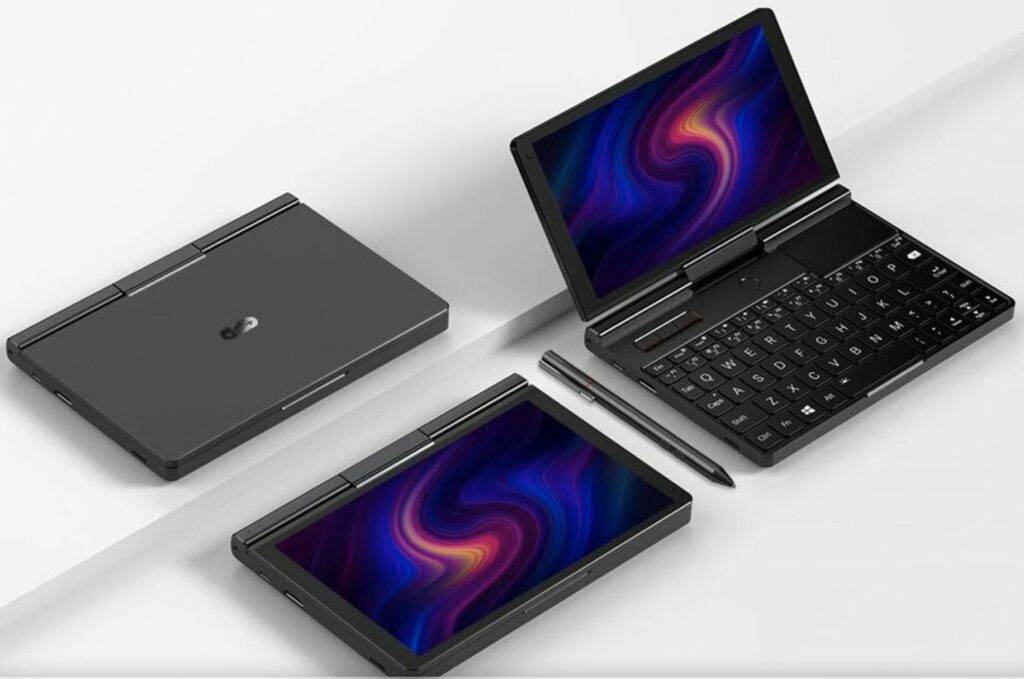
Modulaarsus?
GPD on maininud, et seadme mõned aspektid on modulaarsed, mis tähendab, et need peaksid olema kasutajale kergesti asendatavad. Jääb üle oodata, mis täpselt on seadme puhul modulaarne.
[20/10/2021 ] GPD Pocket 3-l on modulaarne liides seadme tagaküljel, mis kinnitatakse kruvidega. Seda liidest saab vabalt vahetada mitme mooduli vahel, mis võimaldab GPD Pocket 3 paremini kohaneda oma keskkonna ja kasutusviisidega.
Praegu on täheldatud ainult kolme moodulit:
- Standardne USB-moodul, millel on üks USB 3.2 Type-A port (tuleb seadmega kaasa).
- RS-232 jadapordi moodul (ostetakse eraldi).
- KVM-moodul, millel on HDMI-IN port ja USB-IN port (ostetakse eraldi).

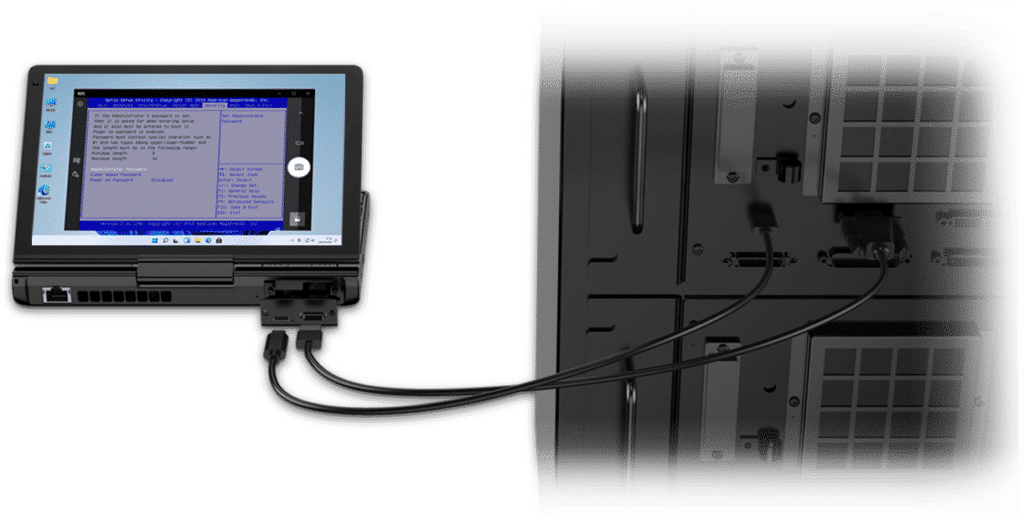
Kui suur on GPD Pocket 3?
GPD väidab, et Pocket 3 on "8 tolli" suurune. Kas nad viitavad ekraanile või kogu seadmele (kui see on suletud), jääb selgusetuks.
[20/10/2021 ] GPD Pocket 3 on väidetavalt umbes 198x137x20mm suur, mis teeb selle mitte palju suuremaks kui mobiiltelefon.
Samuti on selle kaal umbes 725 g, mis teeb selle kandmiseks sobivalt kergeks.
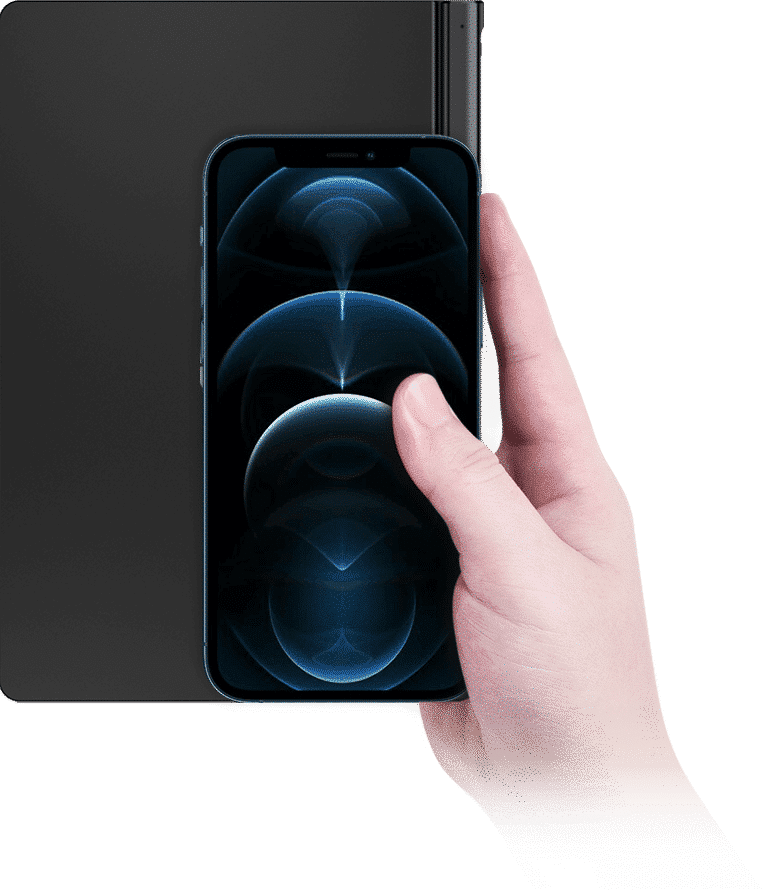
Ekraani pööramine
Pocket 3 ekraani saab pöörata 180 kraadi nii Y- kui ka X-teljel.
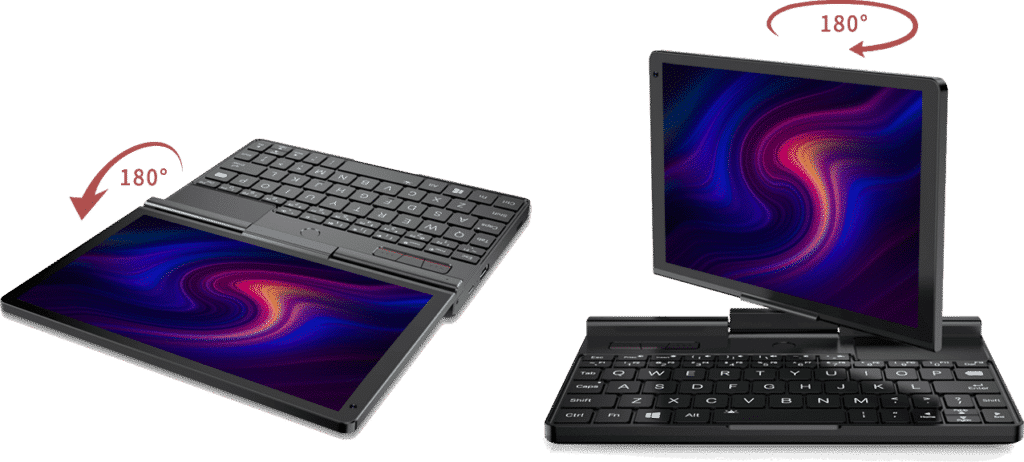
Kui ekraan on mõlemal teljel täielikult pööratud, võtab seade (väga kopsaka) tahvelarvuti kuju. Identne One Netbook A1-ga.
Pliiatsi tugi
Sellega saavutatud kopsakas tahvelarvuti vorm on kasulik, sest seade toetab digitaalseid pliiatseid. Kuni 4096 rõhutundlikkuse tasemega.
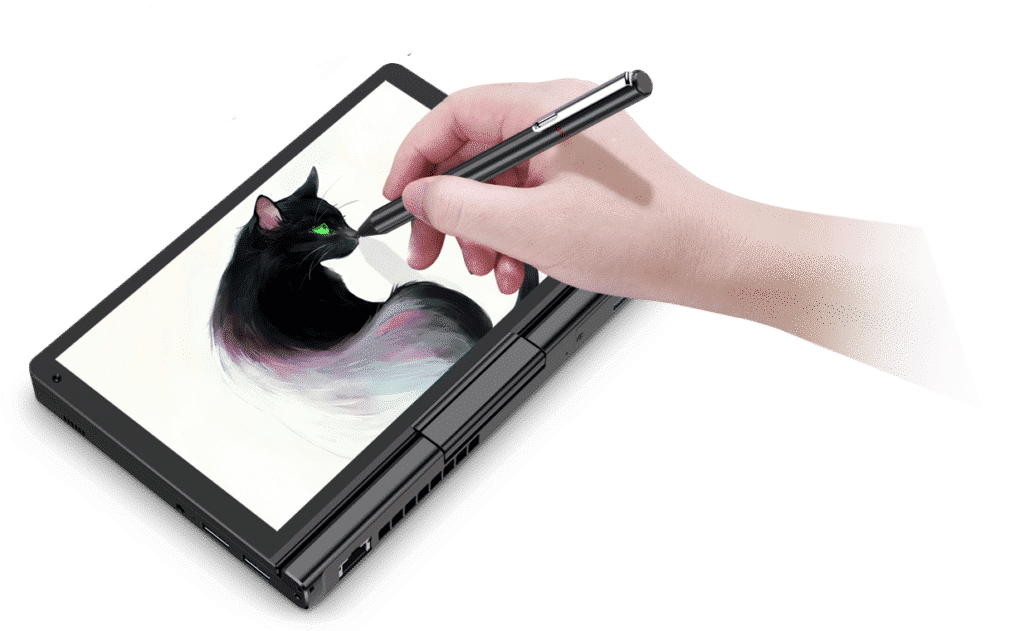
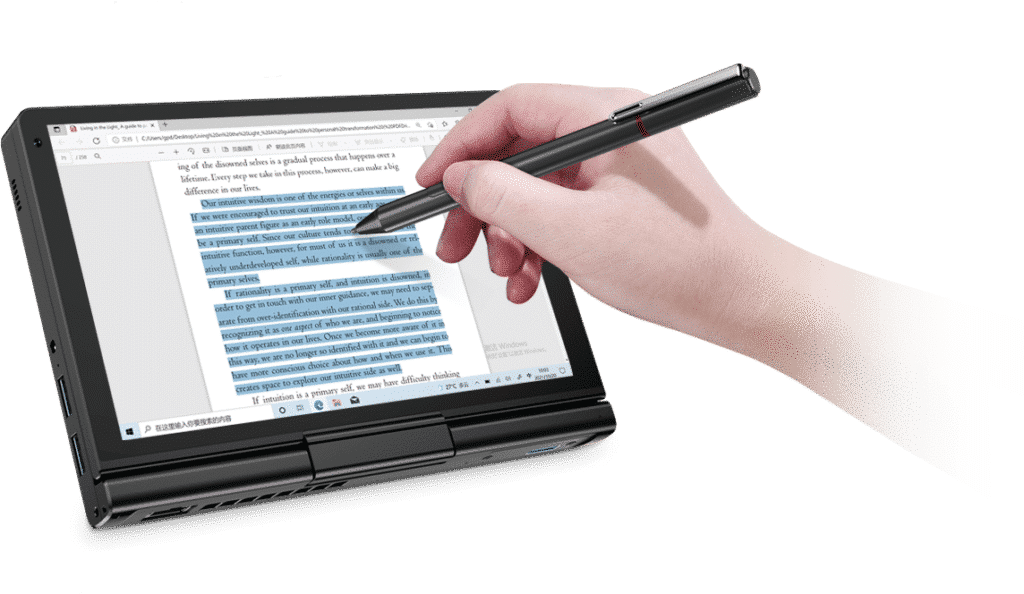
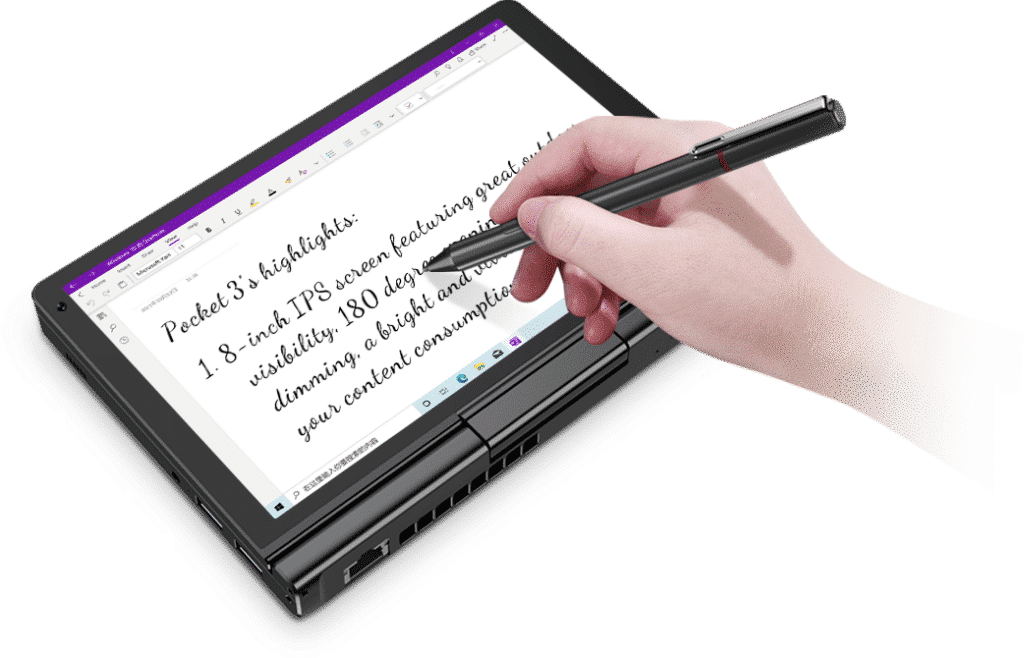
Millal on GPD Pocket 3 ilmumiskuupäev?
Praegusel hetkel ei ole meil veel teavet GPD Pocket 3 väljalaske kuupäeva, hinnakujunduse või selle kohta, millal või kas ühisrahastuskampaania käivitub. Me uuendame siin rohkem infot, kui see selgub.
GPD Pocket 3 hind?
Kuigi GPD Pocket 3 ametlik hind ei ole teada antud, võite tõenäoliselt oodata, et i7-versiooni hind jääb kuskile 800-1000 naelsterlingi vahemikku - lähtudes GPD WIN 3 praegusest hinnast.
Pentium N6000 mudeli hind on aga täiesti lahtine, kuid kahtlemata on see neist kahest mudelist odavam. Tõenäoliselt jääb see 300-600 naelsterlingi vahemikku.
[12/11/2021 Update] GPD Pocket 3 ühisrahastuse lehekülg on käivitatud ja koos sellega on selgunud ka GPD Pocket 3 hinnad.
GPD Pocket 3 (baasmudel/Pentium) on saadaval ühisrahastuse lehel umbes 484 naelsterlingi eest.
Vahepeal on GPD Pocket 3 Pro (high-end/i7 mudel) saadaval 744 naelsterlingi eest.
Mõlemad mudelid on varustatud seadmega kasutatava pliiatsiga.
Baasmudel vastab meie ootustele, kuid meeldiv on see, et kallim mudel on oodatust veidi odavam.
Ostjad saavad ka valida, kas lisada 60 naela lisatasu, et saada lisaks seadmele ka KVM- ja RS-232-moodulid.
[azp_custom_product id="40″]







